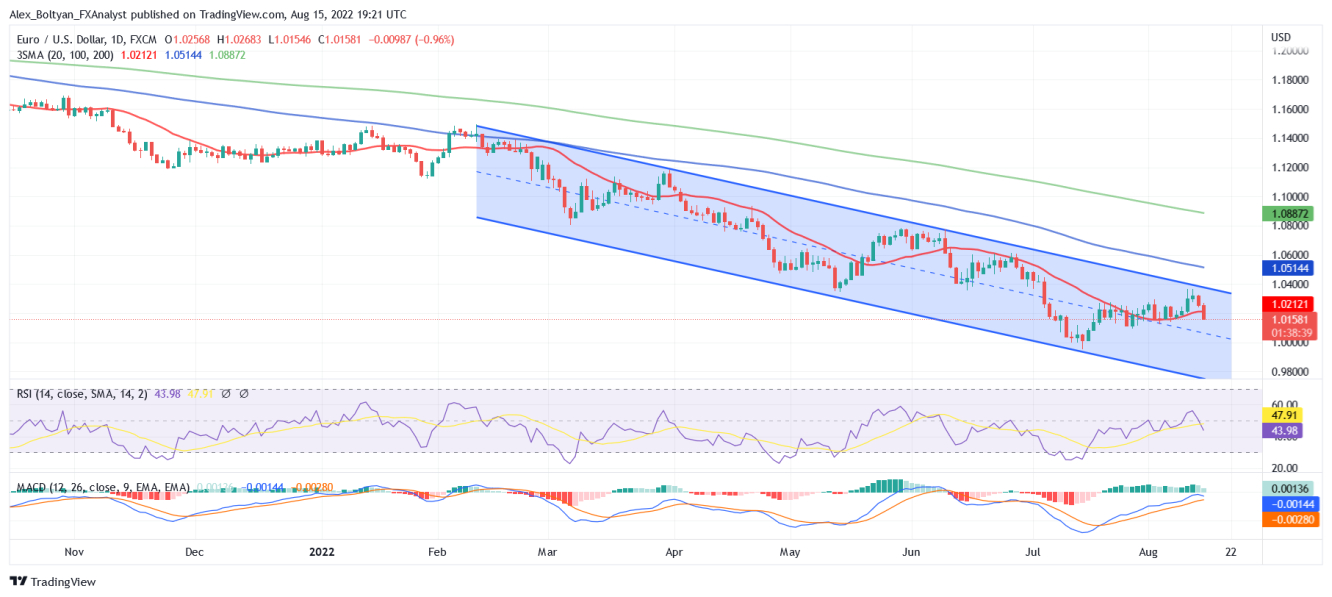The EUR/USD fell back below the 20-day SMA on Monday as the markets started the week in risk-off mode triggered by weak Chinese data that exacerbated global recession fears.
The EUR/USD pair slid below the 1.0200 level and hit a low of 1.0154 during the New York session. It last traded at the 1.0160 zone, recording a 1% loss on the day.
During the Asian session, China published disappointing data that signaled slowing economic activity. Although Chinese retail sales were up 2.7% YoY in July and the Industrial production rose 3.8% in the same period, both readings missed by far the market’s expectations of 5% and 4.6%, respectively. Also, the PBOC (People’s Bank of China) unexpectedly cut a key medium-term policy interest rate, suggesting policymakers are worried about weaker growth.
Against this backdrop, the US dollar rose for a second straight day, posting a 0.8% gain at the 106.50 zone. The yield on the US 10-year note was down 2.19% around 2.77%, suggesting a higher demand for American bonds as the global economic outlook worsens.
From a technical view, the short-term outlook for the EUR/USD has turned neutral, according to indicators on the daily chart. The RSI gained a negative slope and fell below its midline, while the MACD printed lower green bars, indicating dwindling buying interest. On the downside, support levels are seen at the 1.0150 area, followed by the 1.0100 psychological zone. A break below the latter would expose a retest of the parity level and potentially fresh cycle lows.
On the downside, support levels are seen at the 1.0150 area, followed by the 1.0100 psychological zone. A break below the latter would expose a retest of the parity level and potentially fresh cycle lows.
On the other hand, the 20-day SMA at around 1.0213 is now the immediate resistance level to regain for the bulls. A recovery of this level could pave the way towards the 1.0250 zone en route to the 1.0300 area.
- English (UK)
- English (India)
- English (Canada)
- English (Australia)
- English (South Africa)
- English (Philippines)
- English (Nigeria)
- Deutsch
- Español (España)
- Español (México)
- Français
- Italiano
- Nederlands
- Português (Portugal)
- Polski
- Português (Brasil)
- Русский
- Türkçe
- العربية
- Ελληνικά
- Svenska
- Suomi
- עברית
- 日本語
- 한국어
- 简体中文
- 繁體中文
- Bahasa Indonesia
- Bahasa Melayu
- ไทย
- Tiếng Việt
- हिंदी
EUR/USD Loses Critical Level Amid Risk-Off Mood
Latest comments
Loading next article…
Install Our App
Risk Disclosure: Trading in financial instruments and/or cryptocurrencies involves high risks including the risk of losing some, or all, of your investment amount, and may not be suitable for all investors. Prices of cryptocurrencies are extremely volatile and may be affected by external factors such as financial, regulatory or political events. Trading on margin increases the financial risks.
Before deciding to trade in financial instrument or cryptocurrencies you should be fully informed of the risks and costs associated with trading the financial markets, carefully consider your investment objectives, level of experience, and risk appetite, and seek professional advice where needed.
Fusion Media would like to remind you that the data contained in this website is not necessarily real-time nor accurate. The data and prices on the website are not necessarily provided by any market or exchange, but may be provided by market makers, and so prices may not be accurate and may differ from the actual price at any given market, meaning prices are indicative and not appropriate for trading purposes. Fusion Media and any provider of the data contained in this website will not accept liability for any loss or damage as a result of your trading, or your reliance on the information contained within this website.
It is prohibited to use, store, reproduce, display, modify, transmit or distribute the data contained in this website without the explicit prior written permission of Fusion Media and/or the data provider. All intellectual property rights are reserved by the providers and/or the exchange providing the data contained in this website.
Fusion Media may be compensated by the advertisers that appear on the website, based on your interaction with the advertisements or advertisers.
Before deciding to trade in financial instrument or cryptocurrencies you should be fully informed of the risks and costs associated with trading the financial markets, carefully consider your investment objectives, level of experience, and risk appetite, and seek professional advice where needed.
Fusion Media would like to remind you that the data contained in this website is not necessarily real-time nor accurate. The data and prices on the website are not necessarily provided by any market or exchange, but may be provided by market makers, and so prices may not be accurate and may differ from the actual price at any given market, meaning prices are indicative and not appropriate for trading purposes. Fusion Media and any provider of the data contained in this website will not accept liability for any loss or damage as a result of your trading, or your reliance on the information contained within this website.
It is prohibited to use, store, reproduce, display, modify, transmit or distribute the data contained in this website without the explicit prior written permission of Fusion Media and/or the data provider. All intellectual property rights are reserved by the providers and/or the exchange providing the data contained in this website.
Fusion Media may be compensated by the advertisers that appear on the website, based on your interaction with the advertisements or advertisers.
© 2007-2025 - Fusion Media Limited. All Rights Reserved.
